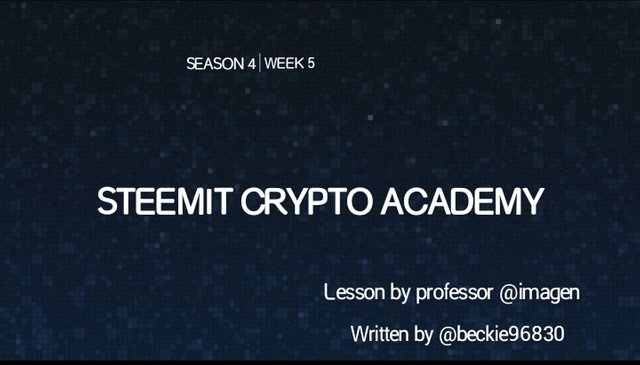
Question 1
How many times has halving been performed on Bitcoin? When is the next one expected? What is the current amount that Bitcoin miners receive? Name at least 2 cryptocurrencies that perform or have performed halving.
Bitcoin Halving
The Bitcoin network introduced the concept of decentralized finance and blockchain technology where financial transactions are carried in a peer-to-peer format. The Bitcoin network transactions are verified through a process called mining, where a number of powerful network nodes (users) called miners, compete to validate each transaction using sophisticated computers in solving complex mathematical computations to find the nonce value of the block. Bitcoin Miners are rewarded with new Bitcoins for verifying and validating transactions.
Bitcoin halving is a process where this reward is split into two, reducing the number of new Bitcoins created to sustain the total number of Bitcoin in circulation. This halving is set to occur after every 210,000 blocks have been created within the Bitcoin network, which translates to about every four (4) years until the total supply is exhausted.
The Bitcoin network has been halved three (3) times, the details are as follows:
1- The first Halving
The first Bitcoin network halving occurred in 2012 when the miner's reward was reduced from 50 BTC to 25 BTC per block mined.
2- The Second Halving
After four years (4), the second halving of the Bitcoin network occurred in 2016 when the miner's reward was reduced from 25 BTC to 12.5 BTC per block mined.
3- The Third Halving
After four (4) years, the last halving of the Bitcoin network occurred on the 11th of May 2020, where the miner's reward was reduced from 12.5 BTC to 6.25 BTC per block mined.
Next Bitcoin Halving
As previously explained and observed, the Bitcoin network is set to be halved every four (4) years until the 21,000,000 BTC total supply is exhausted. The next Bitcoin halving will occur in the year 2024 where the current 6.25 BTC mining reward will be reduced to 3.125 BTC per block mined.
Current Bitcoin Mine reward
With the 11th May 2020 halving, the current mining reward for Bitcoin is 6.25 BTC.
Two Halved Cryptocurrencies
1- Litecoin Halving
Similar to Bitcoin, Litecoin miner's reward is halved after every 840,000 blocks have been created, which translates to every four (4) years. Lite coin was introduced in 2011 by Charlie Lee, and in August of 2015 the first halving occurred. Where the 50 LTC reward was halved to 25 LTC. The next halving will occur in August of 2023.
2- Bitcoin Cash Halving
Bitcoin cash is a hard fork from the Bitcoin network created in 2017, where the Bitcoin Cash network is halved after every 210,000 blocks which translate to every four (4) years. The current reward for mining is 6.25 BCH. The next halving is in 2023 where the miner's reward will be reduced to 3.125 BCH.

Question 2
What are consensus mechanisms and how do Proof-of-Work and Proof-of-Staking differ?
Consensus Mechanisms
The term Consensus Mechanisms in blockchains refer to a generally accepted set standards or protocols adopted in agreeing on the validity of a data (transactions) or a network state (blockchain state) by the nodes connected to the blockchain.
The blockchain consensus mechanisms resulted from the decentralized nature of blockchains where security, reliability, transparency, integrity, and efficiency of the blockchain rely on thousands of individual nodes running on the blockchain distributed ledger software.
The consensus mechanism of a blockchain is used for various activities on the blockchain some of which include governance, mining, regulations, etc. There are different types of consensus algorithms, some include proof-of-history (PoH), proof-of-work (PoW), proof-of-stake (PoS), delegated proof-of-stake (DPoS), proof-of-brain (PoB), etc.
Proof-of-Work (PoW)
The Proof-of-Work (PoW) is a type of consensus algorithm that requires an effort of work to be done on the blockchain by nodes (users) to earn more rights. The required work effort includes verification and validation on on-chain transactions by nodes (miners), where miners use powerful computers to solve complex mathematical computations to find the nonce of a transaction block.
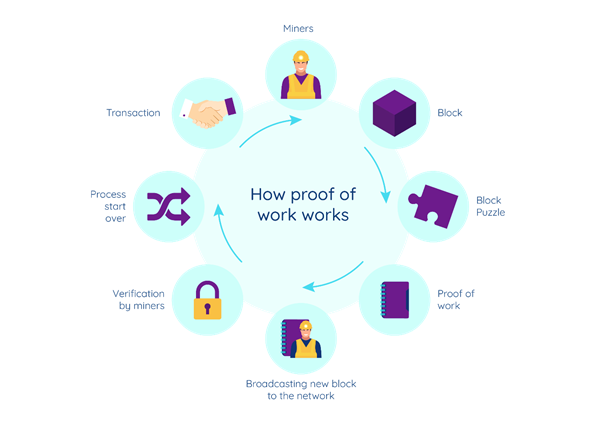
The proof-of-work consensus algorithm is highly cost-effective, because of its high electricity consumption, which results from the usage of powerful computers for mining in attempts to meet up with the blockchain's activities where thousands of transactions are queued on-chain for validation. Ideally, the proof-of-work consensus algorithm takes about 10 minutes to validate a transaction, which relatively slow compare to the expected Bitcoin network throughputs, this leads to congestions and bottlenecks.
Blockchains that use the proof-of-work (PoW) consensus algorithm are Bitcoin, Litecoin, Ethereum, etc.
Proof-of-Stake (PoS)
The Proof-of-Stake (PoS) is a type of consensus algorithm that shares the blockchain's responsibilities based on the number of crypto assets held by the nodes (delegates), allowing more rights and contributions to the selected nodes. This consensus algorithm was created in response to the problems associated with the proof-of-work consensus algorithm which are high cost of operation and high consumption of energy.
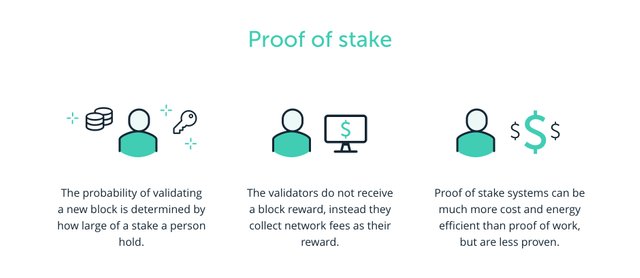
In the proof-of-stake consensus algorithm, network nodes (users) vote (stake) a percentage of their assets to a selected node (delegate). The delegates utilize the staked assets to take on assigned on-chain responsibilities that generally sort for better development and functionality of the blockchain like, validation of transactions, new protocol implementation, governance, creating guild lines, etc.
Blockchains that use the proof-of-stake (PoS) consensus algorithm are Cardano, EOSIO, Polkadot, etc.

Question 3
Enter the Bitcoin browser and enter the hash corresponding to the last transaction. Show Screenshot.
Bitcoin Explorer
For this illustration, I chose Blockchain Bitcoin explorer.
First, visit Blockchain explorer's official website to access the latest Bitcoin transaction.
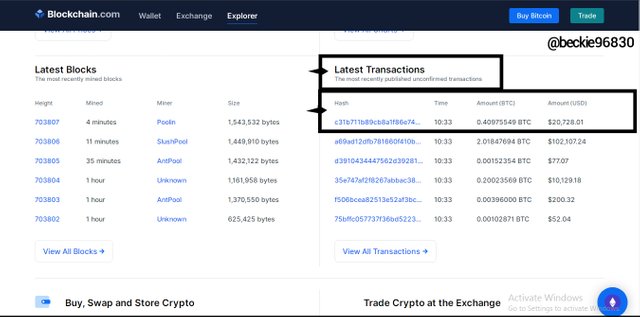
Entering the hash of the latest transaction, the details are as follows:
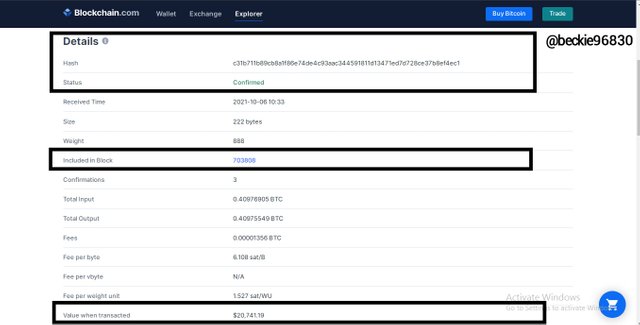
The hash of the latest transaction is:
c31b711b89cb8a1f86e74de4c93aac344591811d13471ed7d728ce37b8ef4ec1
The Bitcoin transaction was added to block: 703808 and the transaction input is 0.40975549 BTC and the output is 0.40975549 BTC which is equivalent to $20,741.19. A transaction fee of 0.00001356 BTC was charged.
Question 4
What is meant by Altcoin Season? Are we currently in Altcoin Season? When was the last Altcoin Season? Mention and show 2 charts of Altcoins followed by their growth in the most recent Season. Reason your answer.
AltCoin Season
AltCoin Season refers to a period within the crypto ecosystem in which crypto assets except Bitcoin increase in market value. This aggregation comes as a result of Bitcoin's 40-50% dominance of the entire crypto market. Ideally, during AltCoin seasons, bitcoin loses some percentage of its dominance to better performing coins. For instance, in the case of Ethereum which rose to over 20% market dominance while Bitcoin's dominance dropped to 40%.
In some cases, analysts refer to altcoin season as a phenomenon that occurs when about 75% of other cryptocurrencies increase value more than Bitcoin within 1 month, 90 days, 1-year intervals.
Current Season
According to the data released by Blockchain center's official website, the current season is Bitcoin season. The AltCoin season index stood at 45 which implies that the Bitcoin season index is about 55, while the AltCoin year index stood at 61, which implied that the year can possibly end as an AltCoin year.
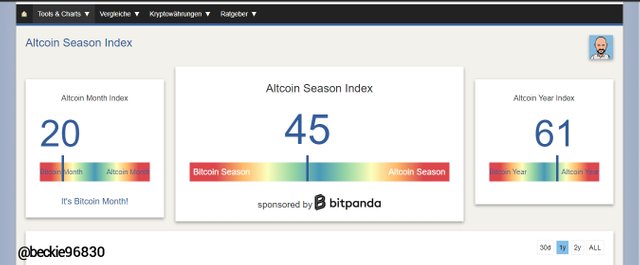
Last AltCoin season
The last AltCoin season lasted between 25th of March 2021 to 21th of June 2021, Where the AltCoin index fluctuated between 73 - 98%. The AltCoin season peaked on the 18th of May 2021 with the altcoin index recording a record high of 98%.
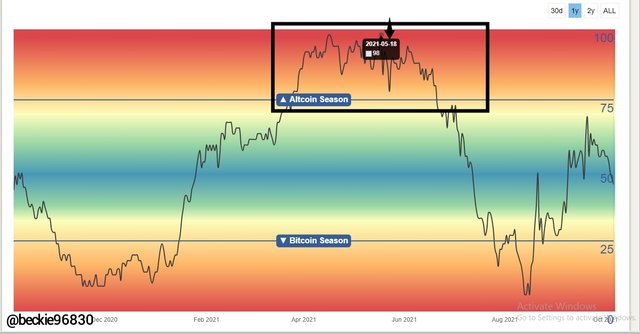
AltCoin growth
According to the data released by Blockchain center's official website, some of the top-performing altcoins in the last season grew in large percentages with the top AltCoin AXS which yielded about 982% in the last AltCoin season.
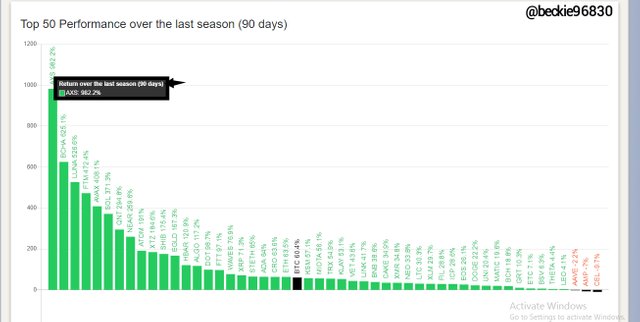
1- AXS Token
AXS is the native token of the Blockchain-based game Axie Infinity, where in-game characters are bought, bred, and sold to earn profits. From the last AltCoin season, the AXS token has grown increasingly. Before the AltCoin season AXS token price was around $3, but from the altcoin season to the recent season, the AXS token reached an all-time high of $155.27 which represented the 982 percentage increase.
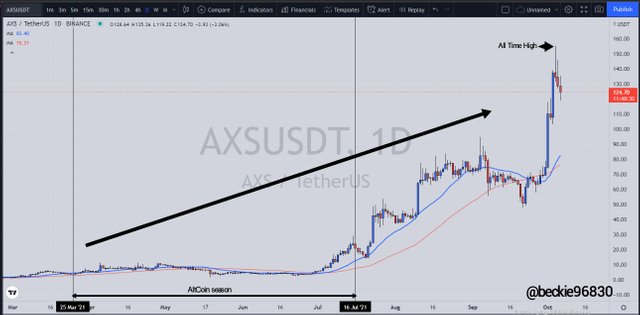
The AXS token has a unit price of $124.43, a market capitalization of 7,578,879,517, and a diluted market cap of $33,596,806,133. AXS traded volume in the last 24 hours is $2,288,320,001.
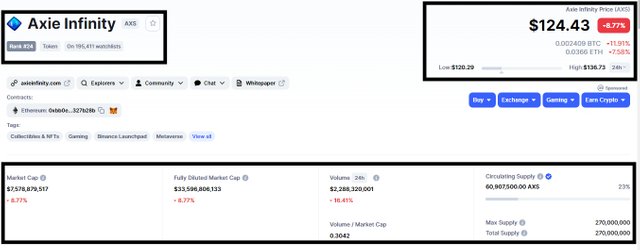
2- BCHA Token
BCHA is the native token of the Bitcoin Cash ABC, which is a Blockchain and Cryptocurrency created from the hard forking of Bitcoin. It was created on the 15th of Nov 2020. From the last AltCoin season, the BCHA token has grown increasingly. Before the AltCoin season BCHA token price was around $33, but from the altcoin season to the recent season, the AXS token reached an all-time high of $400 which represented the 625.1 percentage increase.
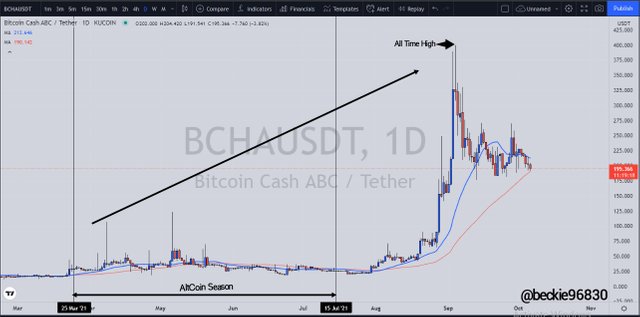
The BCHA token has a unit price of $195.55, a market capitalization of $3,631,899,328 and a diluted market cap of $4,106,510,004. AXS traded volume in the last 24 hours is $30,177.
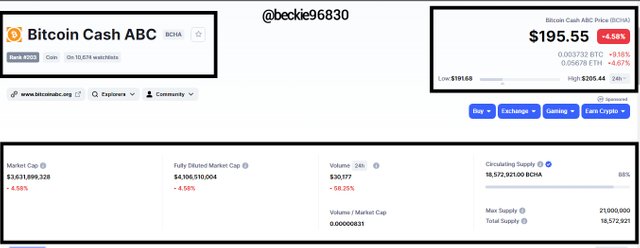

Question 5
Make a purchase from your verified account of the exchange of your choice of at least 15 USD in any currency that is not in the top 25 of Cornmarket (SBD, tron or steem are not allowed). Why did you choose this currency? What is the goal or purpose behind this project? Who are its founders/developers? Indicate ATH of the coin and its current price. Reason your answers. Show screenshots.
BAND Token Investment
For this illustration, I will use Binance exchange to invest.
First, access the exchange through its official website and proceed with the login.
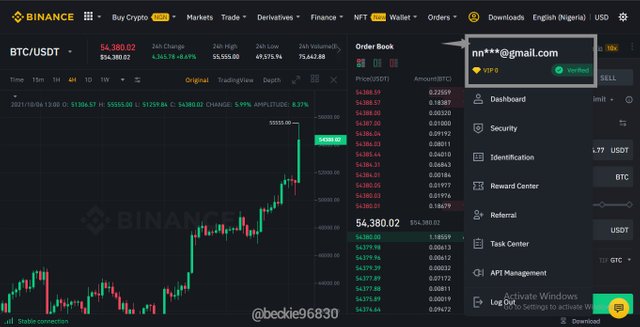
Next, click on trade to access the listed assets.
Then, search for BANDUSDT and choose the pair
Next, choose the appropriate transaction details, transaction type is Buy, choose trade execution type as market, Enter the amount of BAND to be purchased in USDT from the available balance, the click on Buy BAND.
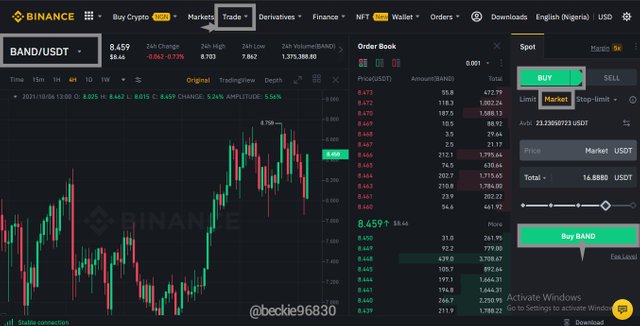
The investment transaction history is recorded on the exchange account.
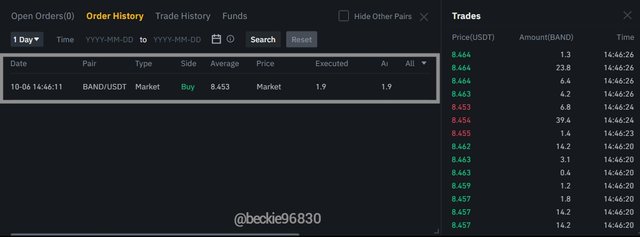
Why BAND Token
I chose BAND Token because of its project and the credibility of the developer behind the project.
BAND Token is the native token of the Band Protocol, which primarily provides Blockchain developers with a collection of real-world data ranging from finance and insurance-related data, weather-related information, sports analytics data, etc. utilized in the development of Decentralized Applications (DApps) on the network. The Band Protocol Oracle project was introduced in 2017 by a team of developers based in Thailand.
Bandchain is a cosmos-based Blockchain that uses the Delegated proof-of-stake (DPoS) consensus algorithm, with high performance in data sourcing and node scalability. Bandchain extended the services of the band protocol to other blockchains, this allowed cross-chain data interfacing, smart contract real-world data sourcing and aggregating, and API services.
This was achieved by creating a central public database that was free for multiple Blockchains and smart contract developers to access sourced and stored data at relatively no cost.
All-Time High
The success of Bandchain and its Oracle project saw the valuation of the BAND token reached an all-time high of $23.305 in April 2021.
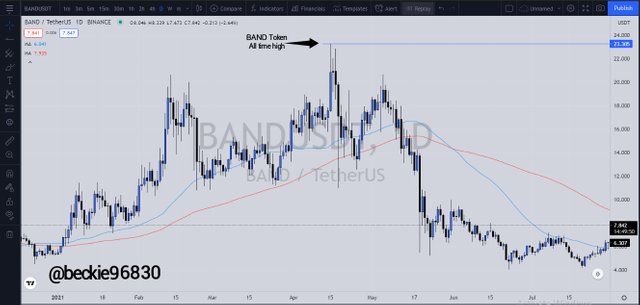
BAND Token Current Price
BAND token has a current value of $8.35 according to popular cryptocurrency information website Coimmarketcap, ranked #178.
BAND token has a market capitalization of $293,817,149 and a diluted market capitalization of $826,436,096. BAND Token traded volume in the last 24 hours is $57,642,443.
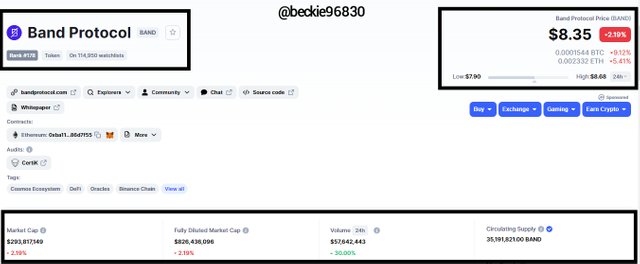
The Circulation supply of the BAND token is 35,191,821 BAND and a total supply of 100,000,000 BAND, this implies that about 64,808,179 BAND tokens can still be created. It has a market dominance of about 0.01%.

Conclusion
Bitcoin halving is a systemic measure placed within the software of Bitcoin to periodically reduced the rate of new bitcoins created in the form of rewards earned by miners for validating transactions. This measure is placed to sustain the total supply of Bitcoin for a sustainable period of years. Similar to Bitcoin some other cryptocurrencies implement halving some of which are Litecoin, Bitcoin Cash, etc.
Consensus Mechanisms is an agreeable measure used within a Blockchain to verify the authenticity of transactions and other protocols within the Blockchain. There are different types of consensus algorithms with each aiming to improve on the concept of previous ones.
Band protocol oracle services provide key function services in decentralized finance through the provision of verifiable real-world data to on-chain, used by smart contract developers to further enhance its function.
Thank you professor @imagen for this educative and insightful lesson.
Gracias por participar en la Cuarta Temporada de la Steemit Crypto Academy.
Felicitaciones!
Continua esforzandote, espero seguir corrigiendo tus asignaciones.
Downvoting a post can decrease pending rewards and make it less visible. Common reasons:
Submit